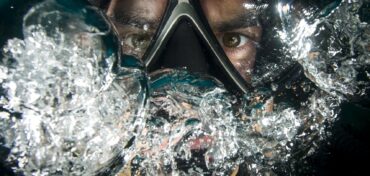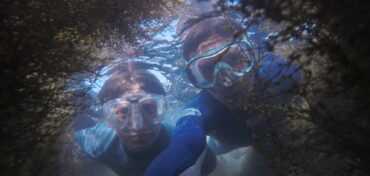
If you are a recreational PADI diver, you might have already experienced the thrill of diving in different environments, such as coral reefs, wrecks, or caves. But have you ever wondered what lies beyond the 18-meter (60-foot) mark? If you are curious about the deep blue, you might want to try a deep open-water dive. A deep dive is any dive deeper than 18 meters, and it can open up a whole new world of diving possibilities. However, it also requires some extra preparation, equipment, and skills. Here are some tips on preparing for a deep open-water dive and what to expect from this adventure.
Get quality training.
Before you can go on a deep dive, you need to have reliable training and certification. The PADI Advanced Open Water Diver course is a great way to start, as it teaches you how to dive up to 30 meters (100 feet) and introduces you to different types of diving, such as night diving, wreck diving, and navigation diving. You will also learn how to use a dive computer, which is essential for deep diving. Look for an experienced dive instructor like By the Shore SCUBA Instruction in Raleigh, NC. Kevin Alexander is a PADI instructor and occasionally books group charters.
Going Deeper
If you want to go deeper, you can take the PADI Deep Diver Specialty course, which focuses on deep diving and covers topics such as gas management, decompression sickness, nitrogen narcosis, and emergency procedures. This course will allow you to dive up to 40 meters (130 feet), the maximum depth for recreational diving.
Choose the right equipment.
Deep diving requires more equipment than shallow diving, as you deal with colder temperatures, reduced visibility, and increased pressure. Here are some of the essential items you will need:
- A dive computer: This device will tell you your depth, time, no-decompression limit, ascent rate, and safety stop information. It will also alert you if you exceed your planned depth, and time, or ascend too fast.
- A dive light: A dive light will help you see better in the dark and communicate with your buddy. It will also make the colors of the underwater world more vivid and reveal hidden creatures.
- A surface marker buoy (SMB): An SMB is a bright-colored inflatable tube you can deploy from depth to signal your position to the boat or other divers. It will also help you ascend safely along a line and avoid drifting away from your planned exit point.
- An alternate air source: An alternate air source is a spare regulator that you can use for emergencies, such as running out of air or having a malfunctioning primary regulator. You can carry your alternate air source or share one with your buddy.
- A dive knife or cutting tool: A dive knife or cutting tool can help you free yourself or your buddy from entanglement or snagging by fishing lines, nets, or ropes.
Plan your dive
Planning your dive is crucial for deep diving, as you will have less time and air available than on shallow dives. Consider decompression stops, gas consumption, nitrogen narcosis, and emergency scenarios. Here are some steps to follow when planning your dive:
Choose a suitable dive site.
Pick a dive site that matches your skill level, interests, and objectives. Become familiar with the layout, conditions, hazards, and site attractions. You can also consult with a local dive guide or operator for advice.
Set your depth and time limits.
Based on your training, certification, and experience, decide how deep and long you want to dive. Use your dive computer or a recreational dive planner (RDP) to calculate your no-decompression limit (NDL), the maximum time you can stay at a given depth without making mandatory decompression stops on your way up.
Estimate your gas consumption.
To avoid running out of air on a deep dive, estimate how much gas you will consume and plan accordingly. You can use your SAC rate (surface air consumption rate) to calculate how much air you use per minute at the surface. Then multiply it by a factor that accounts for the increased pressure at depth. Alternatively, you can use your dive computer which has an integrated air pressure gauge that will tell you how much air you have left in your tank at any time.
Plan your safety stops.
A safety stop is a pause at a shallow depth during your ascent that allows your body to eliminate excess nitrogen and reduce the risk of decompression sickness. Safety stops are recommended for all dives deeper than 10 meters (30 feet), but they are mandatory for dives deeper than 18 meters (60 feet) or dives that approach the NDL. The standard safety stop is 3 minutes at 5 meters (15 feet), but you may need to make additional or longer stops depending on your dive profile and computer.
Plan your emergency procedures.
Before you dive, you and your buddy should agree on an emergency plan, such as running out of air, losing contact, or having equipment problems. You should also know how to recognize and treat the symptoms of decompression sickness and nitrogen narcosis, which are more likely to occur in deep dives.
Enjoy your dive
Once you have completed your training, chosen your equipment, and planned your dive, you can enjoy your deep open water dive. Deep diving can be an exhilarating and rewarding experience. You explore new places, see different marine life, and challenge yourself.
Remember to follow the rules of safe diving, such as:
- Never dive alone or beyond your limits
- Monitor your depth, time, and air
- Ascend slowly and make safety stops
- Stay hydrated and avoid alcohol
- Keep a positive attitude and have fun
Nothing is guaranteed.
Deep diving is a great way to expand your diving skills and knowledge and discover new underwater wonders. However, it also comes with risks and challenges requiring proper preparation and planning. By following the tips we have given you in this blog post, you can ensure that your deep open-water dive will be a safe and enjoyable adventure. Happy diving!
Disclaimer
**This blog post is intended for informational purposes only and does not constitute professional advice. Diving is a potentially hazardous activity that involves inherent risks and requires proper training, certification, and equipment. Always consult with a qualified instructor before attempting any diving activity, especially deep diving. Follow the standards and guidelines of your diving organization and respect the local laws and regulations of your diving destination. Dive within your limits and do not dive under the influence of alcohol or drugs. Diving is a personal choice and you are responsible for your safety and well-being.**
Sources-
https://blog.padi.com/how-to-prepare-for-your-open-water-diver-course
https://www.sidive.com/how-to-prepare-for-your-open-water-course/
https://blog.padi.com/padi-open-water-dives/
https://www.padi.com/courses/open-water-diver
PADI Advanced Open Water Diver certification course
Try Deep Diving | PADI Deep Diver Specialty







